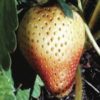This season many growers and agronomists have been finding higher than normal levels of bronzed fruit and there is concern that this bronzing is the result of thrips activity. However, on the farms that Bugs for Bugs crop scouts visit regularly thrips numbers are much lower than what is normally associated with the levels of bronzing being observed. A proportion of this early season bronzing may be attributed to aphids. However, it is difficult to associate most of this bronzing to either thrips or aphids and we believe that environmental conditions have been the main contributing factor.
A considerable amount of research has been conducted in the United States on the causes of bronzing in strawberries. Researchers conducted an extensive study into bronzing in California, where it was being attributed to thrips. They found that only a small proportion of the damage was due to thrips and the majority was a result of environmental conditions. A separate study conducted in Iowa attributed less than 1% of fruit bronzing to thrips despite thrips levels exceeding recognized EILs.
Three distinct types of bronzing have been identified as affecting strawberry fruit, and they are termed Type I, Type II and Type III bronzing.
Type I bronzing
-

-
Type I bronzing
Type I bronzing is the only form of bronzing that is associated with insect pests, primarily thrips. It is localized to areas of the fruit that have been directly feed upon by the pest. This is usually the area under the calyx and the areas outside the indentations formed in the fruit tissue around the seed.
Type II bronzing
-

-
Type II bronzing
Type II bronzing is attributed to chemical burn and is normally associated with the use of pesticides containing sulphur, or other caustic compounds in unfavorable weather conditions. This damage is also localized in nature and is confined to the area directly contacted by the chemical.
Type III bronzing
-

-
Type III bronzing
Type III bronzing is caused by certain environmental conditions, primarily high temperatures, low humidity and high levels of solar radiation. Unlike other types of bronzing, it affects the whole fruit. It is thought to begin in early fruit development when epidermal cells are damaged, resulting in a loss of integrity in the cuticle and epidermis. As the fruit develops and ripens, the bronzing may become less pronounced but the fruit has a dull appearance, texture can become rubbery, and shelf life is reduced. There appear to be differences in susceptibility amongst verities, with lighter coloured fruit being more susceptible than darker fruit. Thrips are often mistakenly blamed, but researchers have found no link between thrips activity and Type III bronzing. At times, this type of bronzing will result in significant reductions in marketable yield.
Researchers have identified environmental conditions and production practices that will have an influence on incidence levels. In California, lower levels of bronzing occur in coastal regions, where regular sea fogs moderate temperature, humidity and light levels. When misters or micro sprinklers are used during peak periods of the day incidence is reduced again due to moderation of temperature and humidity. Pesticides (fungicides or insecticides) applied shortly before periods of high risk also reduce incidence. This is thought to be a result of the sulphinated lignins contained in many pesticides, which are known to provide protection against solar radiation.
Researchers see this type of bronzing as primarily a problem from spring to mid-summer in California and attribute this to a lack of canopy development at this stage of the season. Later in the season a more developed canopy will provide greater moderation of the micro-climate. Increased incidence has also been noted with later plantings, and this has been attributed to reduced canopy development.
Given the generally mild conditions that South East Queensland has experienced so far this season, it is reasonable to question why Type III bronzing would be such an issue. However, during the 2000-2001 strawberry season in the Central Coast region of California there was a significant outbreak of bronzing while researchers were investigating its causes. During this period temperatures at harvest were generally between 15-25 °C with only two days over 30 °C, and peak day solar radiation levels that are comparable to those experienced in South East Queensland this season. It is possible that the combination of a relatively warm and dry autumn, late planting and generally slow plant development early in the season has contributed to an increased incidence of Type III bronzing in South East Queensland this season.
According to crop scouts, levels of bronzing observed in the field have declined over the last week, and we hope that this decline will continue.





